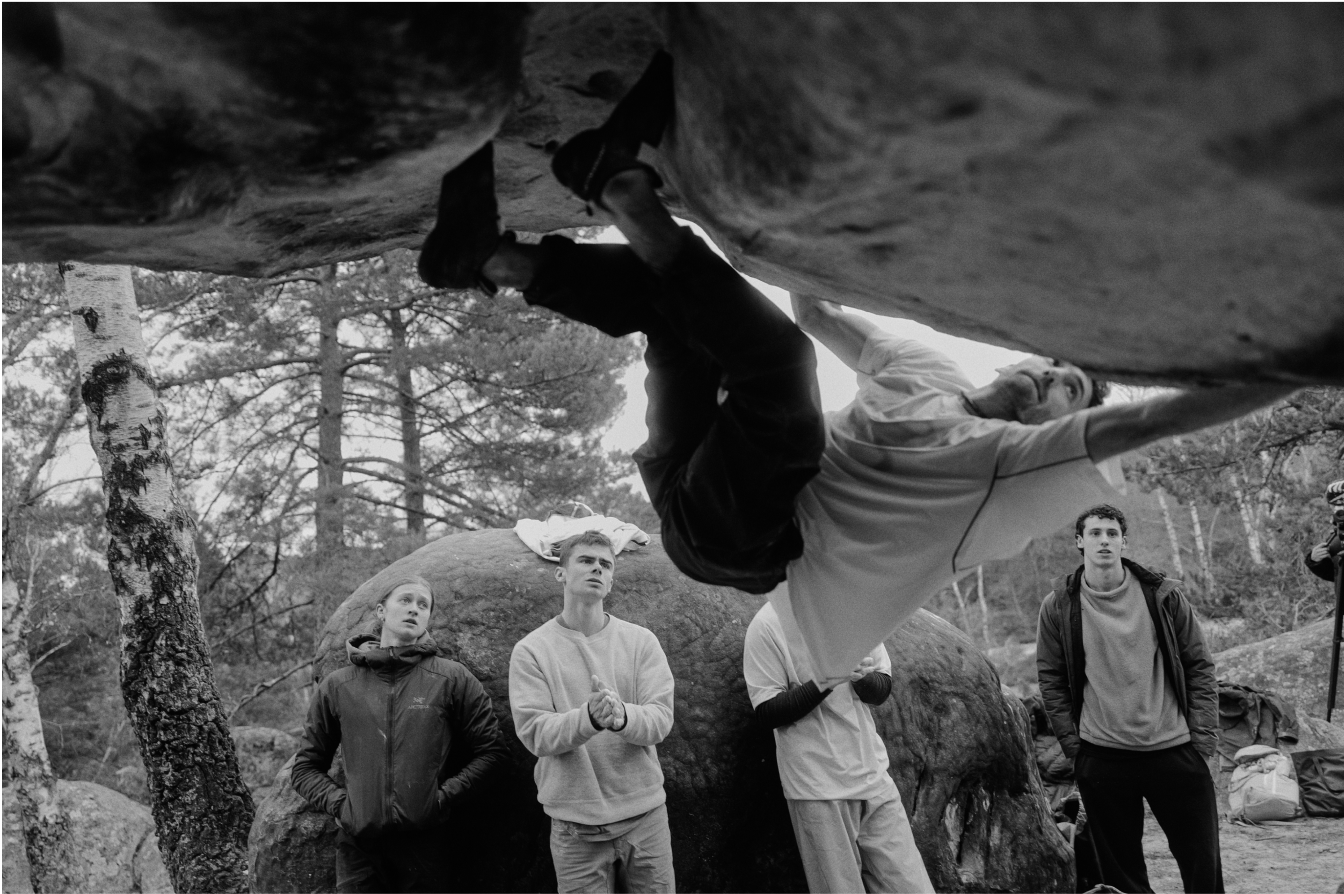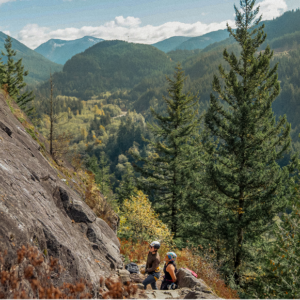As climbing culture grows increasingly obsessed with grades and performance, a new film reminds us that bouldering is so much more. Set in the storied forest of Fontainebleau, a crew of climbers catch a vibe and keep it real.
Content is everywhere, filling space, demanding attention, making promises it cannot possibly keep.
Art, on the other hand, is consciously none of those things. It refuses to be useful to your daily life. It doesn’t have an opinion about what’s an optimal morning routine or how to maximize finger strength. It doesn’t offer anything but an open invitation to discover and create the meaning yourself.
Today’s climbing media landscape is saturated with bouldering content. Uncut send footage and beta videos abound. The focus is skewed toward performance, and the implication is that this is all that matters.
In thinking about how to define climbing—whether it’s a sport, lifestyle, or art—the answer is always “all of the above.” Bouldering is as much a refuge for grade chasers and content creators as it is for seekers and artists. Bouldering can be about performance and sending hard. But it can also be art. A medium for authentic self-expression. An experience of finding profound meaning under the facade of simple, irreverent fun.
“Keep It Real 2” is an invitation to remember a side of bouldering that you’d be forgiven for having forgotten. Watch it and decide for yourself what it all means.
“Being injured, this was a perfect opportunity to reflect, seek less performance-based validation, and see my value outside of the stuff I was climbing.”
—HAMISH MCARTHUR
THE CREW
In their own ways, everyone needed this trip. Ten days in Fontainebleau, France—the world’s first bouldering area and still one of its finest.
Maximillian Milne, Hamish McArthur, Holly Toothill, Kieran Forrest, and Jim Pope are all lifelong friends from the U.K. They’re in their young 20s and have spent most of their lives climbing, training for competitions, and occasionally making forays out onto real rocks in the wild. “We’ve done everything together,” says Hamish. “Traveled the world in every direction.”
Clément Lechaptois and René Grincourt, the film’s director, are from France. Clément, 31, has climbed V16 and works as a route setter and a business owner. René is a former fashion model, a climber of five years, and a visual artist with an unapologetically urban point of view.
Ashima Shiraishi is from New York City. She is one of climbing’s most recognized phenoms. As a 15-year-old, she became the first woman to climb V15. Now, after being in college and stepping back a bit from the cutting edge, she finds herself curious to explore new ways to reinvent climbing for herself.
René says he always wanted to do a film with this group of athletes. “They’re super badass to me. They’re fearless. All they do is train, compete, and try to be the best. But this trip was cool because I got to see their human side, their passion, their vulnerabilities. I understand so much more about them.”
“Bouldering is very intense and precise. When it gets hard, every tiny detail matters. I love the process of finding those subtleties and seeing how they make big differences.”
—CLÉMENT LECHAPTOIS
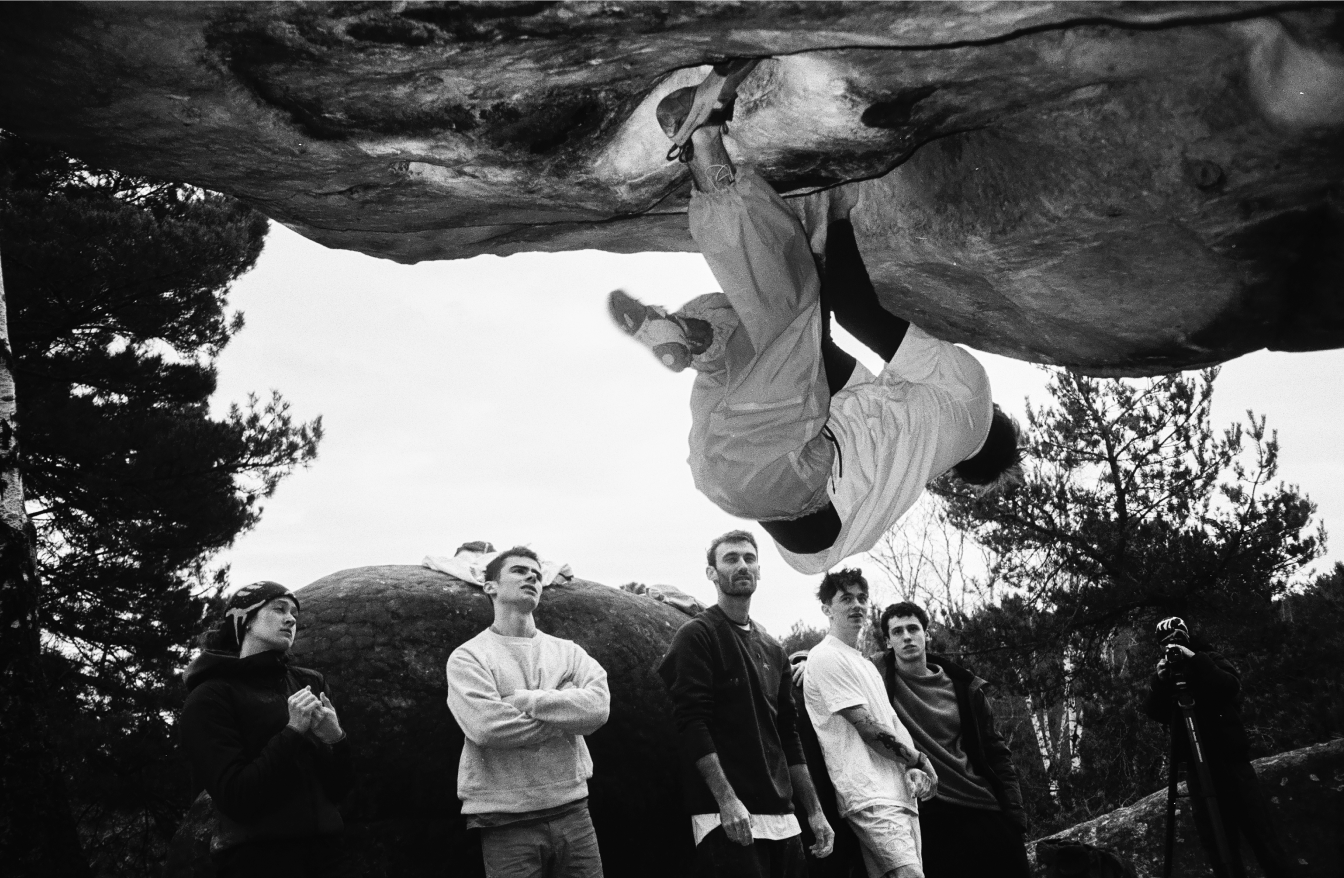
TOUCHING STONE
The writer Jonathan Thesenga once declared that every climber should do El Cap, sink a hand jam in Indian Creek, and touch a Font sloper. Simply pressing your hands onto the fine-grained sandstone “blocs” of Fontainebleau, whose surfaces are sculpted like elephant skin, stand as one of climbing’s peak sensory experiences.
The climbing here demands sophisticated technique, an understanding of movement, balance, and footwork. Font is likely the only place you’ll see those who crush 8a in the gym fall off a 6a that was established 60 years ago.
The landscape evokes a nostalgia for childhood, that desire for guileless play. “The boulders look like mushrooms,” says Ashima. “It’s such a beautiful, whimsical forest. It makes me feel like a kid again.”
“Performance is cool to witness and be excited about, but at the same time it’s just one small sliver of why we enjoy climbing. The social aspect. Creativity. Movement. Having a kinesthetic connection to your body. I think it can enrich our experiences when we lift our focus and emphasize other parts.”
—ASHIMA SHIRAISHI

FREEDOM FROM EXPECTATION
At the start of the trip, Clément was just about fully recovered from a broken back after a bad bouldering fall. Hamish had just ruptured his finger. And Ashima rolled her ankle on the warm-up.
These are high-performing athletes, accustomed to measuring their days by how hard they train, how high they podium, and what they send. The unspoken commitment to simply climb together in Font—not necessarily to project the hardest things ever, but just to explore and create—ended up being a revelation.
“The trip would’ve been rough for me if this wasn’t such an incredible group,” says Hamish. “I didn’t have high expectations because of my injury, but I surprised myself and could climb. The saving grace was it didn’t matter. Everyone had incredible moments, which I lived through vicariously while enjoying their company so much.”
Bouldering is fun. It doesn’t need to be more than that.
With a difficulty rating of 7a+, the boulder problem Le Pilier Légendaire was well within Holly’s abilities. She is one of Britain’s top competition climbers, after all. But the highball problems pushed her in new ways.
“On paper this boulder wasn’t that hard, and actually the moves individually would be quite easy,” she says. “But for me it was more than that … It was a mental challenge. I think it’s cool that one piece of rock, one route, can be a totally unique experience for each person who climbs it.”
“What do I love about bouldering? It’s grounding. Literally, every time I fall off.”
—KIERAN FORREST
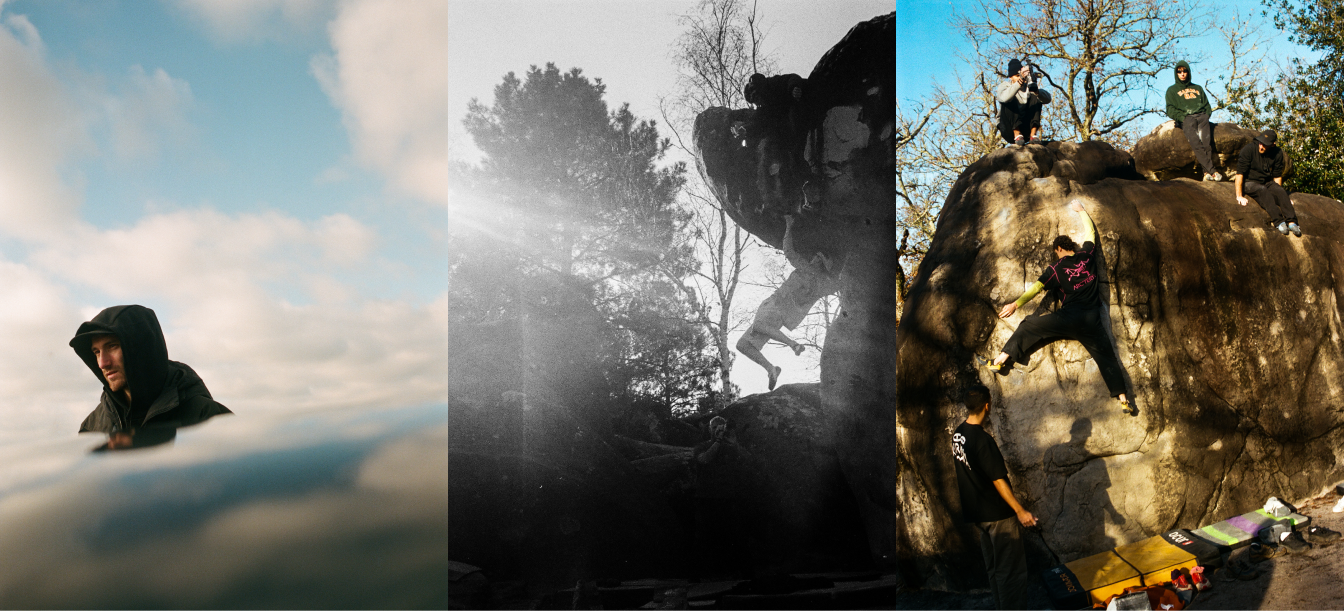
“I think climbing is becoming a sport where it’s quite easy to get sucked into chasing grades and doing things ‘for the photo.’ I think some people lose why they started climbing in that space … Remembering one’s why is important.”
—HOLLY TOOTHILL
KARMA
One of the problems featured in the film is Fred Nicole’s iconic Karma (8a). Somehow, Karma’s three moves capture the entire experience of what it’s like to climb in Font. A three-word poem for bouldering.
“Karma is so pure and very much Font-style: jump to a crimp, slap to a sloper, and mantel to finish,” says Max. “So simple, yet so difficult.”
In the film, you’ll see a climbing shoe placed atop the boulder—which is acting as a visual reference, like a tick mark, to help the climbers see where to aim their toss to the elusive sloper, which is impossible to see from below. One by one, the climbers session the problem, finding just the right body position and momentum to hit the sweet spot and stick it.
Max, Hamish, Holly, and Jim are all on the same climbing team. Along with Kieran, they’re dedicated competitors who may dream of podiums more than first ascents. But being out in the woods, away from the bright lights of the comp stage, the question of authenticity came into stark relief for them.
What does it mean to keep it real?
Everyone says that it’s a question of authenticity. In some ways, it’s the most vital question of our times. The answer, to just be yourself, is exactly like bouldering: so simple, yet so difficult.
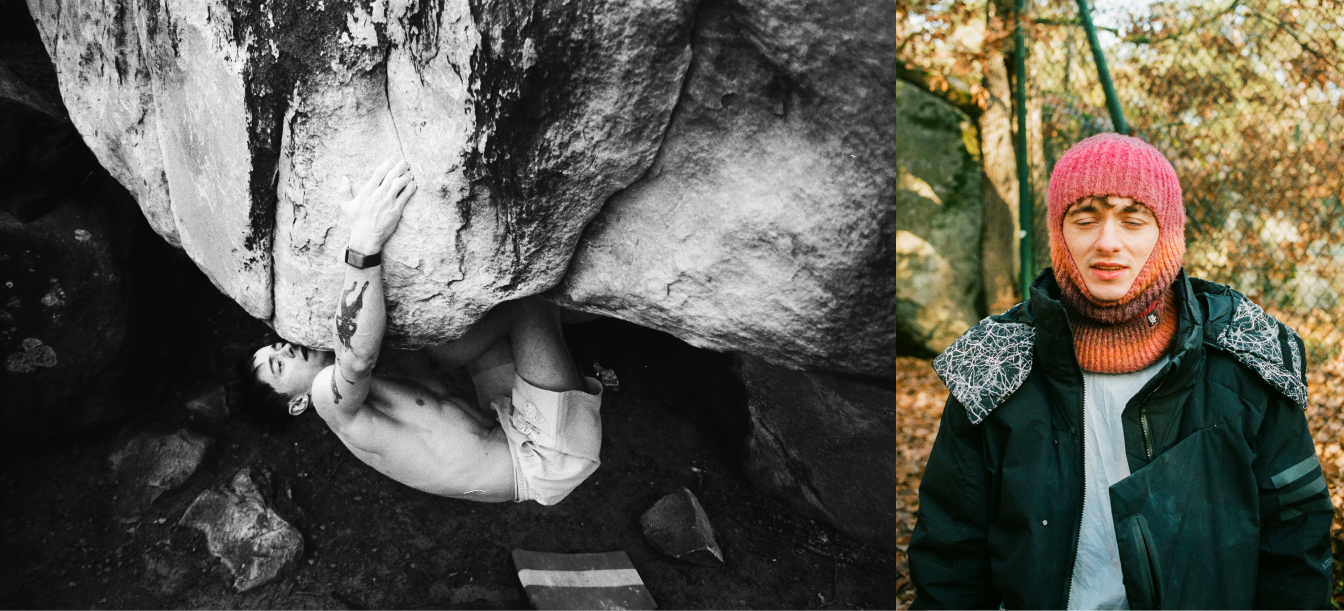
“Keeping it real means being honest, being truly myself in all walks of life—not just when things are going well, but also when they are not.”
—MAX MILNE
THE REAL THING
Keep It Real 2 implies there must be a Keep It Real 1. (There is! Watch it here.) The gritty visual aesthetic established in these series calls to mind climbing’s first-ever bouldering film: The Real Thing.
The Real Thing featured the top brass of the 1990s, Ben Moon and Jerry Moffatt, training and bouldering at Font. Ben and Jerry, through the sheer gravity of their personalities, made training and bouldering look cool. Fast cars, night clubbing, cheeky grins, shirts off, abs for days. “Lad culture,” as the climbing writer Niall Grimes describes it. “Most of the U.K. scene was bogged down headpointing trad climbs, and trading broken limbs for big grades. It was all very cheap. The Real Thing kinda exploded onto the scene and was a real gust of fresh air.”
Here, one sees bouldering’s power to subvert norms in climbing culture, to breathe vitality into its most staid traditions.
Recording to VHS on Super 8, René took a creative chance and bucked the norm of what’s expected in bouldering media, right down to the experience of filming itself. There’s no playback on these cameras. No chance to check the focus. No time spent peering into an LCD screen while action slips away. For René and his partner in cinematography, Gregoire Mithieux, these cameras allowed them to just be there, present to capturing the bouldering lifestyle as it unfurled before them in a menagerie of color, personality, camaraderie, and chalk.
“It’s not really about how you perform or what the grade is. It’s more about the style of doing it,” says René.
“I think we can be proud to come from the city, and not the outdoors. I want to bring the streets into the forest. That’s the vibe I like.”
—RENÉ GRINCOURT

THE BLEUSARDS
Tucked amid over 280 square kilometers of sprawling, arcane forests are thousands of incredible boulders. The region, once walked by French kings on hunting trips, is now a playground for Parisian weekend warriors and international climbers alike.
Font is the true birthplace of bouldering, dating back to La Prestat, a 30-foot crack done by Jaques de Lepiney in 1914. Climbers owe it to themselves to know a bit of the history, starting with the first of each grade: René Ferlet’s Marie Rose (6a) in 1946. Michel Libert’s L’Abattoir (7a) in 1961. And Jacky Godoffe’s C’était Demain (8a) in 1984.
The Bleusards, as these proto-boulderers were called, helped pave the way for climbing as we know it today.
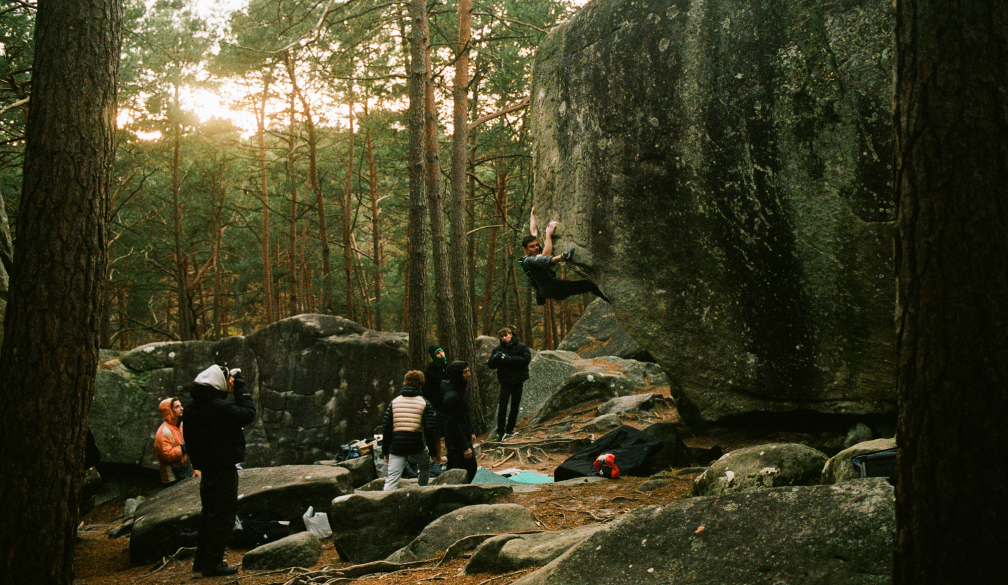
“I do more bouldering than anything else, but I pride myself on doing a bit of everything: trad, sport, big-wall, comp. If you enjoy all aspects of climbing, you get so much more.”
—JIM POPE
SHARING
The story goes that Jacky Godoffe and Marc Le Menestrel were each trying to send a striking arête in the area called Buthiers. The boulder is a paradigm of climbing aesthetics, with just enough holds to make it possible. At some point, both Jacky and Marc succeeded—though, in a nod of respect to each other, neither would say who did it first. They called the boulder Partage (8a+), which means “sharing,” and shared the honors of the first ascent.
On this trip, Jim flashed Partage—potentially a first. It was a moment he calls maybe the best of his climbing life.
“I’ve never been the most self-confident climber,” Jim says. “My training and comps hadn’t been going that well, so doing this gave me a boost in confidence that things are still heading in the right direction.”
“The sounds he made are ones I’d never heard before!” Hamish says, who, in all the years of climbing together, had never heard Jim shriek quite like that. “Watching Jim flash Partage was the most memorable moment of the trip for me.”
Bouldering may be an artful lifestyle, but performance is indelibly etched into this pursuit as well. Those performances become most meaningful when shared with friends, ideally on an all-time trip, far from the gravity of expectation, where you can just be yourself.
